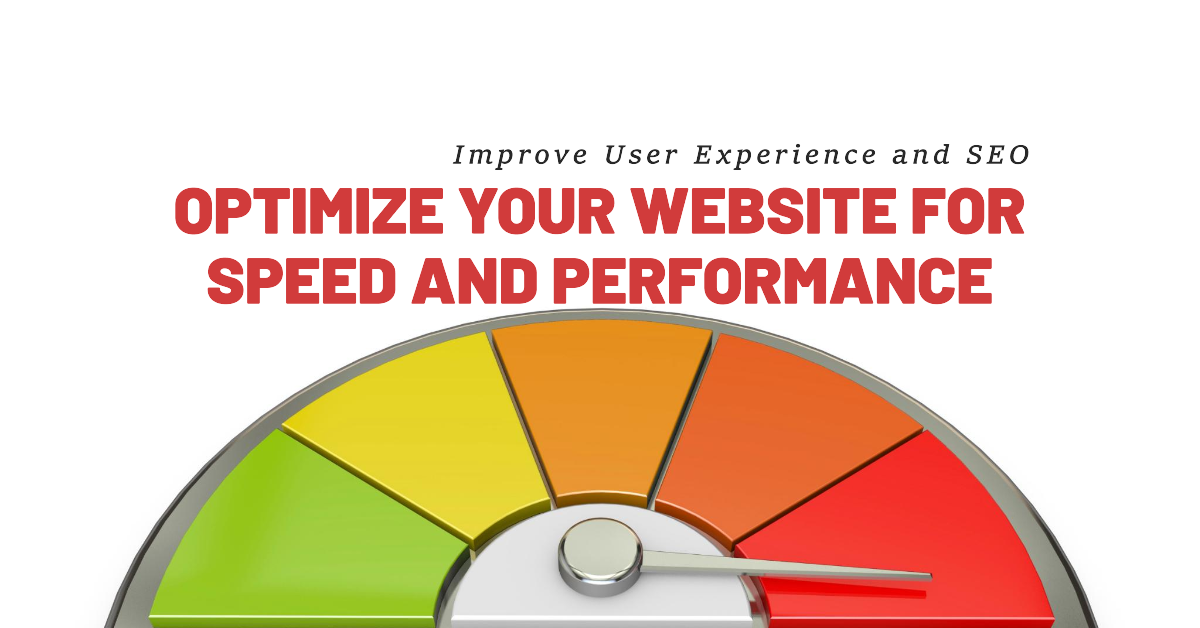In today’s digital landscape, having a fast and high-performing website is essential for online success. A slow-loading website can lead to high bounce rates, poor user experience, and decreased conversions. On the other hand, a fast and optimized website improves user satisfaction, increases engagement, and boosts search engine rankings. In this comprehensive guide, we will explore the key strategies and best practices for optimizing your website’s speed and performance. From code optimization to image compression, we will cover everything you need to know to ensure your website delivers a seamless user experience.
Why Website Speed Matters
Website speed is a critical factor that directly impacts user experience and conversion rates. Studies have shown that users are highly sensitive to page load times, with even a one-second delay leading to increased bounce rates and decreased customer satisfaction. Additionally, search engines like Google consider website speed as a ranking factor, meaning that faster websites are more likely to appear higher in search results. Therefore, it’s crucial to prioritize website speed optimization to enhance user experience, boost conversions, and improve search engine visibility.
Factors Affecting Website Speed
Several factors contribute to the overall speed and performance of a website. It’s important to identify and address these factors to ensure optimal speed and user experience. The key factors affecting website speed include:
- Hosting Provider: The quality and performance of your hosting provider play a significant role in website speed. Choosing a reliable and reputable hosting provider, preferably one that specializes in website speed optimization, can greatly enhance your website’s performance.
- Code Optimization: Optimizing your website’s code is crucial for reducing load times. Minifying CSS and JavaScript files, removing unnecessary code, and compressing files can significantly improve your website’s speed.
- Image Optimization: High-resolution images can significantly slow down your website. Optimizing images by compressing them without compromising quality, using the correct file formats, and lazy loading can dramatically reduce load times.
- Caching: Implementing caching mechanisms, such as browser caching and server-side caching, allows your website to store and serve static content, reducing the need for repetitive requests and improving load times.
- Content Delivery Network (CDN): Utilizing a CDN helps distribute your website’s content across various servers worldwide, reducing latency and improving load times for users in different geographical locations.
- Database Optimization: Optimizing your website’s database by removing unnecessary data, optimizing queries, and implementing caching can improve overall website performance.
- Mobile Optimization: With the increasing number of mobile users, it’s essential to optimize your website for mobile devices. Implementing responsive design, optimizing images and videos for mobile, and reducing server requests can enhance mobile performance.
Website Speed Testing
Before implementing any speed optimization techniques, it’s crucial to assess your website’s current speed and performance. Several online tools can help you analyze and measure your website’s speed, providing valuable insights and recommendations for improvement. Some popular website speed testing tools include:
- Google PageSpeed Insights: This tool analyzes your website’s performance on both desktop and mobile devices, providing a detailed report with suggestions for optimization.
- GTmetrix: GTmetrix offers comprehensive performance reports, including page load times, file sizes, and recommendations for improvement.
- Pingdom Website Speed Test: This tool allows you to test your website’s speed from various locations worldwide, providing insights into potential performance issues.
- WebPageTest: WebPageTest offers a detailed analysis of your website’s speed, including waterfall charts, performance grades, and optimization suggestions.
By utilizing these tools, you can identify areas of improvement and track your progress as you implement speed optimization techniques.
Code Optimization
Optimizing your website’s code is one of the most effective ways to improve website speed and performance. By reducing file sizes, eliminating unnecessary code, and optimizing scripting languages, you can significantly enhance load times. Here are some key code optimization techniques:
- Minify CSS and JavaScript: Minifying CSS and JavaScript files involves removing unnecessary characters, whitespace, and comments from the code. This reduces file sizes and improves load times. Several tools and plugins are available to automate this process.
- Combine Files: Combining multiple CSS and JavaScript files into one reduces the number of HTTP requests, resulting in faster load times. However, it’s important to ensure that the combined file is cached properly to avoid unnecessary requests.
- Use Asynchronous Loading: Asynchronous loading allows scripts to load independently of other website elements, preventing them from blocking the rendering of the page. This technique enhances website speed by allowing the browser to load other elements while the scripts are being fetched.
- Optimize Code Structure: Well-organized and efficient code structure improves website performance. Avoid redundant code, eliminate unused functions, and optimize loops and conditional statements to minimize execution time.
- Utilize Content Delivery Networks (CDNs): CDNs store copies of your website’s static files, such as CSS and JavaScript, on servers worldwide. When a user requests your website, the CDN serves the files from the server closest to their location, reducing latency and improving load times.
Image Optimization
Images play a crucial role in website design and engagement, but they can also significantly impact load times. Optimizing images is essential for reducing file sizes without compromising quality. Here are some image optimization techniques:
- Compress Images: Use image compression tools or plugins to reduce the file size of images without sacrificing quality. Lossless compression techniques preserve image quality, while lossy compression techniques achieve higher compression rates but may slightly affect image quality.
- Choose the Right File Format: Selecting the appropriate file format for each image can reduce file sizes. For photographs or images with many colors, use JPEG format. For logos, icons, or images with few colors, use PNG format. For images with transparency, use PNG-24 or WebP format.
- Resize Images: Resize images to match the dimensions required by your website. Uploading large images and scaling them down using HTML or CSS leads to unnecessary data transfer. By resizing images before uploading, you reduce file sizes and improve load times.
- Lazy Loading: Implement lazy loading techniques to load images only when they are visible in the viewport. This prevents unnecessary load times for images that users may not immediately see, improving overall website speed.
Caching
Caching is a vital technique for improving website speed by storing static content and delivering it quickly to users. There are different types of caching that can be implemented to enhance website performance:
- Browser Caching: By setting appropriate caching headers, you can instruct the user’s browser to store static files locally, reducing the need to fetch them from the server on subsequent visits. This significantly improves load times for returning visitors.
- Server-Side Caching: Implementing server-side caching mechanisms, such as opcode caching or object caching, can store dynamically generated content and serve it quickly to users, reducing the load on the server and improving overall website performance.
- Database Caching: Utilize database caching techniques, such as query caching or object caching, to store frequently accessed data in memory, reducing the need to fetch it from the database on each request. This improves website speed and reduces database load.
Content Delivery Network (CDN)
Implementing a Content Delivery Network (CDN) can have a significant impact on website speed, especially for users located far from your web server. Here’s how a CDN works and how it improves website performance:
- Server Distribution: A CDN consists of multiple servers distributed across various geographical locations. When a user requests your website, the CDN automatically serves the content from the server closest to their location, reducing latency and improving load times.
- Caching: CDNs cache static content, such as images, CSS files, and JavaScript, on their servers. This means that subsequent requests for the same content can be served directly from the CDN’s server, reducing the load on your web server and improving load times.
- Load Balancing: CDNs can distribute traffic evenly across multiple servers, ensuring that your website can handle high volumes of traffic without compromising speed or performance.
Mobile Optimization
With the increasing number of mobile users, optimizing your website for mobile devices is crucial. Here are some key strategies for mobile optimization:
- Responsive Design: Implement a responsive design that adapts to different screen sizes and devices. This ensures that your website looks and functions optimally on mobile devices, improving user experience and reducing bounce rates.
- Mobile-Friendly Images and Videos: Optimize images and videos for mobile devices by compressing them and using appropriate file formats. This reduces the load on mobile connections and improves load times.
- Reduce Server Requests: Minimize the number of server requests by combining and minifying CSS and JavaScript files. This reduces the amount of data that needs to be transferred, improving load times on mobile devices with slower connections.
- Accelerated Mobile Pages (AMP): Consider implementing Accelerated Mobile Pages (AMP), a framework that optimizes web pages for fast loading on mobile devices. AMP pages are lightweight and prioritize speed, ensuring a seamless user experience.
Database Optimization
Optimizing your website’s database can significantly improve overall performance. Here are some key techniques for database optimization:
- Remove Unnecessary Data: Regularly clean up your database by removing unused data, such as post revisions, spam comments, and expired sessions. This reduces the size of the database and improves query performance.
- Optimize Database Queries: Review and optimize your website’s database queries to ensure they are efficient and well-structured. Use indexes, avoid unnecessary joins, and optimize complex queries to minimize execution time.
- Implement Database Caching: Utilize database caching techniques to store frequently accessed data in memory, reducing the need to execute complex queries on each request. This improves website speed and reduces database load.
Ongoing Maintenance and Monitoring
Optimizing your website for speed and performance is an ongoing process. It’s important to regularly monitor your website’s performance, implement updates and optimizations, and stay up to date with the latest industry trends. Here are some key maintenance and monitoring practices:
- Regular Performance Audits: Conduct regular performance audits using website speed testing tools to identify areas for improvement. Monitor load times, file sizes, and other performance metrics to track progress and ensure optimal website speed.
- Stay Updated: Keep your website’s CMS, plugins, and themes up to date to ensure compatibility, security, and performance improvements. Regularly check for updates and implement them promptly.
- Monitor Server Performance: Monitor your server’s performance, including CPU usage, memory usage, and disk space. Optimize server configurations, consider upgrading hardware if necessary, and ensure your hosting provider meets your website’s needs.
- Implement Content Delivery Networks (CDNs): If your website’s traffic grows or you have a global audience, consider implementing a CDN to ensure fast content delivery worldwide. Regularly monitor CDN performance and make adjustments as needed.
- Testing and Optimization: Continuously test and optimize your website’s speed and performance. Experiment with different techniques, monitor the results, and refine your optimization strategies based on data-driven insights.
Optimizing your website for speed and performance is crucial for providing a seamless user experience, improving search engine visibility, and maximizing conversions. By implementing the strategies and best practices outlined in this guide, you can significantly enhance your website’s speed and ensure optimal performance. Regular maintenance, monitoring, and ongoing optimization are key to maintaining a fast and high-performing website. Remember, website speed is a critical factor in today’s digital landscape, and investing in optimization will yield long-term benefits for your online presence. Contact us today to learn more about how we can help you optimize your website for speed and performance.


